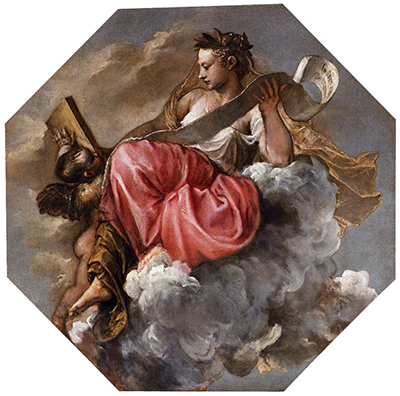As Titian grew older, he decided to review his own style of painting. He looked at other painters and the progressive painting of the time. He revised his own style of painting and began to use an almost impressionist-style to his paintings.
The depiction of Wisdom painted with oils on canvas was created in 1560 by Titian. Titian began to paint symbolic and metaphorical subjects, including Wisdom. This depiction of Wisdom was painted on the ceiling of an entrance to a room in Sansovino's library and was an octagon shape. The painting is now located in Biblioteca Marciana, Venice, Italy, a library and Renaissance-style building in Venice.
Wisdom is surely the best depiction for an entrance to a reading-room in a library. Titian's Wisdom is a surreal painting showing a female subject as wisdom reclining on a cloud with a written scroll over her body and looking into either a book or a mirror. The association with clouds is an aerial quantity that would suggest thinking, the scroll and book would suggest reading; and if the book is a mirror, this would suggest wisdom can be found by looking. It is a totally surreal painting of the idea of wisdom. This is perfectly set in the correct place - an entrance to a reading-room in the library. Titian uses wisdom reclining and floating on clouds as a depiction to show that wisdom is a separate condition and is a thinking state.
Titian's later work, with elements of styles that had not been seen before, brought about an artistic style which used symbolism and surreal surroundings for many subjects. His techniques have been called 'patchy painting' for these later works. He may have been failing in eyesight and health, but he also wanted to remain separate from his peers by using another style of painting. He used his fingers to blend some of the colours and gave his characters more depth. Some artists thought he could not hold a brush properly as he was ageing, but it appears as a deliberate change of style. Some of his late works are held in the Kunsthistorisches Museum.
The true impressionist artists would arrive several centuries later, spearheaded by Claude Monet.
Titian began his painting by learning to paint frescoes and portraits, and he became famous and well-renowned for his work. He was a very prominent artist throughout his life and only began to change his style of painting in his later years. Whether age, his own knowledge and artistic experience gave him the confidence to try something new, or whether he was just experimenting with a new style; his later impressionist paintings are full of feelings and emotions. This is a great artistic distance from the set portraiture of his earlier work.




